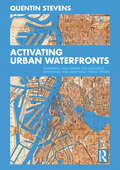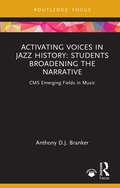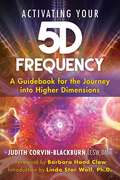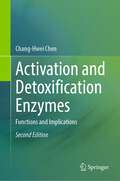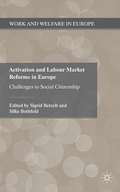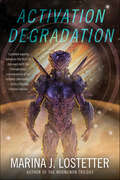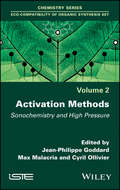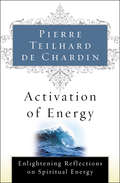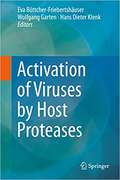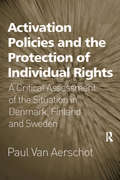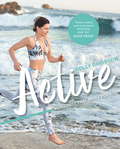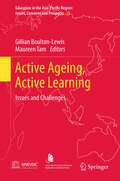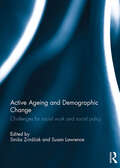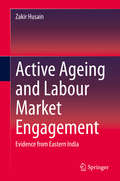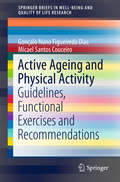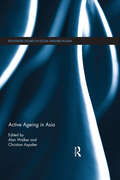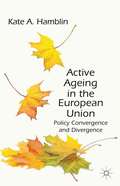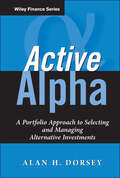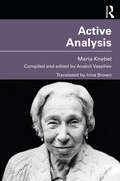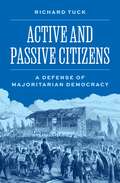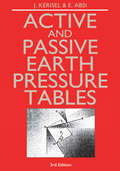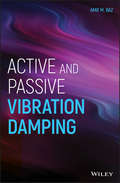- Table View
- List View
Activating Urban Waterfronts: Planning and Design for Inclusive, Engaging and Adaptable Public Spaces
by Quentin StevensActivating Urban Waterfronts shows how urban waterfronts can be designed, managed and used in ways that can make them more inclusive, lively and sustainable. The book draws on detailed examination of a diversity of waterfronts from cities across Europe, Australia and Asia, illustrating the challenges of connecting these waterfront precincts to the surrounding city and examining how well they actually provide connection to water. The book challenges conventional large scale, long-term approaches to waterfront redevelopment, presenting a broad re-thinking of the formats and processes through which urban redevelopment can happen. It examines a range of actions that transform and activate urban spaces, including informal appropriations, temporary interventions, co-design, creative programming of uses, and adaptive redevelopment of waterfronts over time. It will be of interest to anyone involved in the development and management of waterfront precincts, including entrepreneurs, the creative industries, community organizations, and, most importantly, ordinary users.
Activating Voices in Jazz History: Students Broadening the Narrative (CMS Emerging Fields in Music)
by Anthony D.J. BrankerActivating Voices in Jazz History: Students Broadening the Narrative highlights the research of students who have been challenged to assess and interpret evidence found in historical records and engage in field interviews with a diverse representation of jazz artists. This approach serves as a method for co-creating a living history of jazz.Drawing from the author’s experience in teaching jazz historiography and recognizing that Jazz, African American music, and the music of the African diaspora offer unique perspectives rooted in culture and community, the book presents a culturally relevant view of the history of jazz. It also proposes a much-needed alternative methodology for teaching this subject. The author reflects on the issues that shape the framing of jazz history and discusses how using a dialogic approach can enable students to engage in critical conversations. The student-led interviews with artists focus on themes such as diversity and inclusion, gender equity, social justice, cultural identity and identification, what the word “jazz” represents, primitivism, reflections on pedagogy, the current state of jazz education, and the development of artistic voice and creative self-expression.This concise book will be a valuable resource for jazz educators, scholars, students, and enthusiasts alike.
Activating Your 5D Frequency: A Guidebook for the Journey into Higher Dimensions
by Judith Corvin-BlackburnA guide to navigating the transition from 3D to 5D and reclaiming the ancient powers of love, creativity, and unity consciousness lying dormant in our DNA • Details what is happening psychologically, emotionally, and socially with the dimensional shift and provides a vision of life on 5D Earth • Offers transformative activations and tools to meet the psycho-spiritual demands of this transition, including identifying and integrating the shadow self, healing emotional wounds, and discovering higher frequencies • Explains how to navigate the Ascension process, especially in terms of handling emotions, resistances, and fears, and how to welcome these new frequencies We are in a time of great transition. Higher frequency light is flooding our planet, awakening large numbers to reclaim our original nature as fifth-dimensional humans. As 5D humans, we live from our heart&’s wisdom, from Unity Consciousness, unconditional love, and unbridled creativity. 5D humans have highly developed inner senses of empathy, telepathy, clairvoyance, and clairsentience--qualities that are opening for many as we go through this dimensional shift. While this journey is exciting, its demands can be overwhelming. In this hands-on guide to activating the 5D potential lying dormant in our DNA, Judith Corvin-Blackburn shows us how to navigate the Ascension process, including how to handle emotions, resistances, and fears and welcome our 5D frequencies. Using the 9-dimensional-axis theory first explored by Barbara Hand Clow, the author details what is happening psychologically, emotionally, and socially with the dimensional shift, including revealing the denser, pain-inducing frequency of being a 3D human and the challenges of the 4th dimension. She offers transformative activations and tools to explore and master the psycho-spiritual demands of this transition, including identifying and integrating the shadow self, healing emotional wounds that hold us back, and discovering higher frequencies and the cellular vibration of unconditional love and Oneness. Once we reclaim ourselves as loving, conscious, creator beings and realize we are part of a global 5D team, together we can consciously help co-create a New Earth by anchoring the 5D frequency in both our inner and outer worlds.
Activation and Detoxification Enzymes: Functions and Implications
by Chang-Hwei ChenHumans are exposed to foreign compounds such as drugs, household products and environmental chemicals by swallowing or breathing. Also, food is considered a foreign compound. Such foreign compounds can be non-essential and non-functional to life, and commonly are referred to as xenobiotics. Some xenobiotics are not toxic; however, many of them are potentially toxic or become toxic after conversion to metabolic intermediates. A considerable number of foreign compounds belong to non-polar, lipophilic substances. Lipophilic compounds are not soluble in water. Metabolic conversion of lipophilic foreign compounds to facilitate their removal from the body is essentially carried out by biochemical reactions catalyzed by two classes of metabolizing enzymes, namely, activation enzymes and detoxification enzymes. Activation enzyme-catalyzed functionalization reaction introduces a functional group to a lipophilic compound. Functionalization modifies many foreign compounds to form reactive intermediates capable of interacting with cellular components (proteins, DNA and lipids), leading to a variety of conditions for diseases. Functionalized compounds are further metabolized through detoxification enzyme-catalyzed reactions, which result in an increase in the solubility of parent compounds and an inactivation of metabolic intermediates, thus facilitating their excretion from the body. To minimize the exposure of potentially toxic metabolic intermediates, it is essential to keep them at a minimum level. Extensive investigations have revealed that foreign compound-metabolizing enzymes exhibit genetic polymorphisms. Variations in their activities can produce different results as to the susceptibility to potential toxic effects. Moreover, the expressions of activation enzymes and detoxification enzymes are inducible. A number of chemical compounds are capable of acting as modulators for these two classes of enzymes. These findings have lead to the proposal of modulating metabolizing enzymes as a useful approach for human health benefits. Importantly, many of these chemical compounds are present in human daily diets. There are many advances that have been made in the past decades towards the understanding of functions and implications of activation enzymes and detoxification enzymes. An organized, concise overview is needed for the readers who are initially exposed to this important subject, particularly for students and researchers in the areas of biomedical sciences, biochemistry, nutrition, pharmacology and chemistry. This book is intended to serve this purpose as an introduction to the subject. Furthermore, major topics in the book, excluding catalytic reactions and structural properties, may have interest to other readers who have knowledge of basic sciences and understanding enzyme related information. The book discusses subjects associated with foreign compound metabolizing enzymes with emphasis on biochemical aspects, including lipophilic foreign compounds, catalytic properties, reactive intermediates, biomedical and biochemical effects, genetic polymorphisms, enzyme inducibility, enzyme modulation for health benefits, dietary related enzyme modulators, and structural characteristics of enzyme inducers.
Activation and Detoxification Enzymes: Functions and Implications
by Chang-Hwei ChenThis book discusses the many advances in the understanding of the functions and implications of activation and detoxification enzymes. This organized, concise overview will meet the needs of those who are initially exposed to this important subject, particularly for students and researchers in the areas of biomedical sciences, biochemistry, nutrition, pharmacology, and chemistry. The book will also be valuable to advanced researchers. The book discusses subjects associated with foreign-compound-metabolizing enzymes with emphasis on biochemical aspects, including lipophilic foreign compounds, activation and detoxification enzymes, metabolic enzyme catalytic properties, reactive metabolic intermediates, biomedical and biochemical effects, genetic polymorphisms, enzyme inducibility, enzyme modulation for health benefits, dietary-related enzyme modulators, and structural characteristics of enzyme inducers. This new edition is updated throughout andfeatures completely new chapters on Oxidative and Electrophilic Stresses, Metabolite- Mediated Disease Conditions, and Defense Mechanism: Nrf2-ARE Pathway.
Activation and Labour Market Reforms in Europe: Challenges to Social Citizenship
by Sigrid Betzelt Silke BothfeldThis book analyzes in what way activation policies impact on given patterns of social citizenship that predominate in national contexts. It argues that the liberal paradigm of activation introduced into labour market policies in all Western European states challenges the specific patterns of social citizenship in each country.
Activation Degradation: A Novel
by Marina J. LostetterThe Murderbot Diaries makes first contact in this new, futuristic, standalone novel exploring sentience and artificial intelligence through the lenses of conflicted robot hero Unit Four, from Marina Lostetter, critically acclaimed author of Noumenon, Noumenon Infinity, and Noumenon Ultra.When Unit Four—a biological soft robot built and stored high above the Jovian atmosphere—is activated for the first time, it’s in crisis mode. Aliens are attacking the Helium-3 mine it was created to oversee, and now its sole purpose is to defend Earth’s largest energy resource from the invaders in ship-to-ship combat. But something’s wrong. Unit Four doesn’t feel quite right. There are files in its databanks it can’t account for, unusual chemical combinations roaring through its pipes, and the primers it possesses on the aliens are suspiciously sparse. The robot is under orders to seek and destroy. That’s all it knows. According to its handler, that’s all it needs to know.Determined to fulfill its directives, Unit Four launches its ship and goes on the attack, but it has no idea it’s about to get caught in a downward spiral of misinformation, reprograming, and interstellar conflict. Most robots are simple tools. Unit Four is well on its way to becoming something more....
Activation Methods: Sonochemistry and High Pressure
by Jean-Philippe Goddard Max Malacria Cyril OllivierActivation Methods examines recent improvements in the utilization of ultrasonic waves and pressurized gases to generate reactions. A straightforward method to use, sonochemistry allows chemical reactions to be carried out under ultrasound without the need for external heat, reagents or catalysts – leading to high yields and the production of a minimum amount of waste. This book presents an overview of the main applications of sonochemistry in green organic chemistry, with an emphasis on texts published within the last few years. High-pressure chemical reactions offer innovative solutions to problems relating to synthesis. They allow access to new products and a further understanding of reaction mechanisms. This book presents the characteristics of hyperbaric activation, which allow the integration of an arsenal of tools for green chemistry, such as the lowering of energy costs and of by-products, as well as the possibility of using substrates that are sterically congested and generally inert.
Activation of Energy: Enlightening Reflections on Spiritual Energy
by Pierre Teilhard de ChardinThe renowned Jesuit thinker explores science, theology, and the course of human evolution. Following in the footsteps of his earlier works, this collection of essays from Pierre Teilhard de Chardin brings greater clarity to the stunning potential of human energy if it is properly channeled, as he describes, &“upward and outward.&” While energy wrongly directed appears as depression, drug addiction, and violence, this legendary scholar—a priest who earned a doctorate in geology and studied the sciences extensively—promises that spiritual energy channeled correctly will become a true force in the universe, far outdistancing the potential of technological advance. &“Like other great visionary poets—Blake, Hopkins, Yeats—Teilhard engages the reader both intellectually and sensually.&” —The Washington Post Book World
Activation of Viruses by Host Proteases
by Eva Böttcher-Friebertshäuser Wolfgang Garten Hans Dieter KlenkPresents recent findings on this topic.<P><P> Deals with all aspects of the role of proteases in virus activation.<P> Explores the topic from different points of view.<P>This book will give an overview on viruses undergoing proteolytic activation through host proteases. The chapters will be organized in three themed parts, the first part describing respective viruses and their characteristics in detail. In the second part the molecular and cellular biology of the proteases involved as well as their physiological functions will be further explored. The third part will contain a chapter on protease inhibitors that are promising tools for antiviral therapy.<P> This book will engage scholars in virology and medical microbiology as well as researchers with an interest in enzymology and protein structure and function relationship.
Activation Policies and the Protection of Individual Rights: A Critical Assessment of the Situation in Denmark, Finland and Sweden
by Paul Van AerschotIn Denmark, Finland and Sweden the evolution of administrative law, including social welfare law, has been marked by a shift towards a stronger protection of the recipient's individual rights. The adoption of activation policies targeting recipients of social assistance has highlighted the tensions between decision-making concerning the implementation of these policies and the legislative efforts to promote the realisation of individual rights in the field of social welfare. An examination of the legislation in question and its implementation conditions shows that the realisation of individual rights is subordinated to the pursuit of organisational and other objectives. The findings of the study are used to formulate proposals for the promotion of individual rights based on the Nordic egalitarian model of citizenship. This critical assessment of activation policies should be of broad international appeal. It will be of interest to researchers in social policy, as well as those concerned with protection of rights.
Active: Workouts that work for you
by Holly Davidson'Holly makes exercise seem effortless and fun.' - Sadie FrostWe all want to feel fit, healthy and strong, but with today's fast-paced lifestyles it can be hard to find the time or motivation to work out. Holly Davidson is a top personal trainer who has used her years of experience to devise an exercise programme that is varied, flexible, fun and easy to fit into your day to day life.Holly is used to working with clients who have jam-packed schedules, so she has dozens of clever tips that will help fit your workout into your regular routine. This book will guide you to maximise the experience of training anywhere, and to use these tools and techniques to craft a regime that is not boring, repetitive, monotonous, but instead varied and diverse.Holly's sustainable, holistic approach is based on balance and setting realistic and achievable goals. It's not about crash dieting or scrambling to get a bikini body - it's about integrating fitness into your lifestyle and making workouts work for you.With her encouraging tone and easy-to-follow exercise routines, Holly is with you every step of the way. Feel happy. Feel healthy. Feel strong. And get active!
Active: Workouts that work for you
by Holly DavidsonWe all want to feel fit, healthy and strong, but with today's fast-paced lifestyles it can be hard to find the time or motivation to exercise. What if there was a way to find the fitness that's right for you - workouts that will fit into the time and space you have available?Holly Davidson is a top personal trainer who works according to the fundamental belief that fitness is within each one of us, and we can find it wherever we are. She has used her years of experience to devise an exercise programme that is varied, flexible and fun. She is used to working with clients who have jam-packed schedules, so she has dozens of clever tips that will help fit your workout into your regular routine. This book will guide you to maximise the experience of training anywhere, and to use these tools and techniques to craft a regime that is not boring, repetitive, monotonous, but instead varied and diverse.Holly's sustainable, holistic approach is based on balance and setting realistic and achievable goals. It's not about crash dieting or scrambling to get a bikini body - it's about integrating fitness into your lifestyle and making workouts work for you.With her encouraging tone and easy-to-follow exercise routines, Holly is with you every step of the way. Feel happy. Feel healthy. Feel strong. And get active!
Active Ageing, Active Learning: Issues and Challenges (Education in the Asia-Pacific Region: Issues, Concerns and Prospects #15)
by Gillian Boulton-Lewis Maureen TamThis book is concerned with the general issues of ageing, learning and education for the elderly and then with the more specific issues of why, how and what elders want to learn. This monograph consists of 10 chapters written by various internationally renowned researchers and scholar-practitioners in the field.
Active Ageing and Demographic Change: Challenges for social work and social policy
by Siniša Zrinščak and Susan LawrenceAlthough demographic change has been a widely discussed topic for decades, its scope, social impact and related policy responses leave us with many unresolved social issues. Demographic change is a reality for all European societies but the ways in which it is taking place differ from country to country. Active ageing both as a concept and policy response to the demographic ageing of populations has been widely debated, researched and utilised, informing both policy and practice, and providing a common narrative framework to ageing. However, there continues to be a lack of clarity around the precise meaning of ‘active ageing’.This book explores the way in which social work is critically engaging with the theme of active ageing, in light of, or maybe as a reaction to, the policy responses witnessed within the context of large-scale and rapid demographic change. This book was originally published as a special issue of the European Journal of Social Work.
Active Ageing and Labour Market Engagement: Evidence from Eastern India
by Zakir HusainThe book provides an interesting analysis of the time-use data to examine the extent to which active ageing is occurring in India. It also synthesizes data from the National Sample Survey Office All India Survey and another survey undertaken in Kolkata, Bhubaneswar, and Ranchi (capital cities of East Indian states) to examine the role of the aged in the Indian Society. Nearly all countries in the world are experiencing an important issue of ageing. India faces its own set of challenges with its aging population due to the absence of a social security system—the shifting family dynamics questions the contribution of the elderly to the family in every aspect. Econometric models have been used in the book to study gender differences and variations across socio-economic conditions, correlating them to the contribution of the aged to their families and the extent of active ageing. The book broadens the understanding on the aged and facilitates their integration in the society so that they can age more actively. Active Ageing and Labour Market Engagement offers an analytical perspective to professionals, researchers, and policy makers interested in gerontology.
Active Ageing and Physical Activity: Guidelines, Functional Exercises and Recommendations (SpringerBriefs in Well-Being and Quality of Life Research)
by Gonçalo Nuno Figueiredo Dias Micael Santos CouceiroThis book presents an analysis of active ageing and physical activity from a multidisciplinary perspective. With descriptions of exercises, adequately illustrated with pictures, this book shows that regular physical activity reduces the prevalence of chronic diseases associated with ageing, as well as the risk of morbidity and mortality of the elderly. It confirms that exercise programs minimize the psychomotor decline, prevent the loss of functionality, inability and dementia, and foster significant gains in health and well-being, leading to increased quality of life of the elderly.
Active Ageing in Asia (Routledge Studies in Social Welfare in Asia)
by Alan Walker Christian AspalterEast Asian societies are changing rapidly, and one of the most important facets of this transformation is population the ageing. of society. "Active ageing" is one of the few concepts available today to effectively address the problems arising from a highly-aged and, particularly in East Asia, fast-ageing society, offering a new social policy paradigm to redirect and innovate new social policies, particularly social services, social transfers, social regulations and laws, towards more investment in and support of the fast rising number of olderelderly citizens. This book focuses on the experiences of East Asian societies where active ageing has been implemented. It presents a thorough analysis of the concept of active ageing and its potential and problems of implementations in different stages of development in East Asia, whilst providing theoretical clarity to, and broadening the concept of, active ageing. Further, the country-focused case studies explore how to design, pursue, measure and evaluate social policies, highlight the problems related to the implementation of the concept of active ageing in social policy and outline the practical implications of active ageing theory forin policy making. Active Ageing in Asia will appeal to students and scholars of social and public policy, social work, gerontology and health and social administration, as well as to policy makers working in the field.
Active Ageing in the European Union
by Kate A. HamblinThis book explores the adoption of 'active ageing' policies by EU15 nations and the impact on older peoples' work and retirement policy options. Policies examined include unemployment benefits, active labour market policies, partial pension receipt, pension principles, early retirement and incentives for deferral.
Active Alpha
by Alan H. DorseyPraise for Active Alpha"Active alpha is the quest for every sophisticated investor. This book covers all of the key alpha sources currently mined by active managers, reduces the complexity of the subject, and helps the investor get started in the right direction."-Mark Anson, Chief Executive Officer, Hermes Pensions Management Ltd."Long-held traditional methods for investing large portfolios are giving way to new processes that are designed to improve productivity and diversification. These changes find their locus in the sometimes overly mysterious world of absolute return strategies. In this book, Alan Dorsey demystifies that new world and provides a guiding pathway into the future of professional portfolio management. This is an important read for any investor who plans to succeed going forward."-Britt Harris, Chief Investment Officer, Teacher Retirement System of Texas"With great lucidity, Alan Dorsey's book, Active Alpha, fills an important void by identifying the relevant institutional features of this complex subject and by providing a unifying analytic framework for understanding and constructing portfolios of alternative assets. For anyone investing in the alternative class, from the new student to the experienced practitioner, Active Alpha is a necessary read. I am recommending it to everyone I know with such an interest, and it is destined to become a much thumbed reference on my shelf."-Steve Ross, Franco Modigliani Professor of Financial Economics, Sloan School, MIT
Active Analysis
by Maria KnebelActive Analysis combines two of Maria Knebel’s most important books, On Active Analysis of the Play and the Role and The Word in the Actor’s Creative Work, in a single edition conceived and edited by one of Knebel's most famous students, the renowned theatre and film director, Anatoli Vassiliev. This is the first English translation of an important and authoritative fragment of the great Stanislavski jigsaw. A landmark publication. This book is an indispensable resource for professional directors, student directors, actors and researchers interested in Stanislavski, directing, rehearsal methods and theatre studies more generally.
Active and Passive Citizens: A Defense of Majoritarian Democracy (The University Center for Human Values Series #56)
by Richard TuckA powerful case for why majority rule—not representation—is the defining feature of democratic politicsThe idea that democratic governance rests on active self-rule by citizens plays surprisingly little part in current theories of democracy, which instead stress the importance of representation by elected, appointed, or randomly selected bodies such as legislatures, courts, and juries. This would have astonished eighteenth-century theorists of democracy, who viewed universal suffrage and majoritarian voting as the sole criteria for democratic politics. Active and Passive Citizens defends the view of these earlier thinkers, asserting that individual agency is the very essence of democracy.In this provocative and lucidly argued book, Richard Tuck draws on the distinction made by the Abbé Sieyès, a leading political theorist of the French Revolution, between &“active&” citizens (the electorate) and &“passive&” ones (those who are represented by the institutions of the state). Tuck traces our current representative view of democracy to Sieyès and contrasts him with Rousseau, a theorist of active self-rule by the people. Tuck argues that modern theories of democracy have effectively turned us into passive citizens and calls for a renewal of a majoritarian democracy that realizes the full potential of active citizenship.Based on the prestigious Tanner Lectures delivered at Princeton University&’s Center for Human Values, Active and Passive Citizens is edited and introduced by Stephen Macedo and includes commentary by political theorists Simone Chambers, Joshua Cohen, John Ferejohn, and Melissa Schwartzberg.
Active and Passive Earth Pressure Tables
by E. AbsiThe problem of earth pressure on retaining structures is one of the oldest in soil mechanics. This volume comprises tables which facilitate calculations in problems of limit equilibrium. These tables provide coefficients which are extreme values in which the soil still is in equilibrium. They are or
Active and Passive Vibration Damping
by Amr M. BazA guide to the application of viscoelastic damping materials to control vibration and noise of structures, machinery, and vehicles Active and Passive Vibration Damping is a practical guide to the application of passive as well as actively treated viscoelastic damping materials to control vibration and noise of structures, machinery and vehicles. The author — a noted expert on the topic — presents the basic principles and reviews the potential applications of passive and active vibration damping technologies. The text presents a combination of the associated physical fundamentals, governing theories and the optimal design strategies of various configurations of vibration damping treatments. The text presents the basics of various damping effective treatments such as constrained layers, shunted piezoelectric treatments, electromagnetic and shape memory fibers. Classical and new models are included as well as aspects of viscoelastic materials models that are analyzed from the experimental characterization of the material coefficients as well as their modeling. The use of smart materials to augment the vibration damping of passive treatments is pursued in depth throughout the book. This vital guide: Contains numerical examples that reinforce the understanding of the theories presented Offers an authoritative text from an internationally recognized authority and pioneer on the subject Presents, in one volume, comprehensive coverage of the topic that is not available elsewhere Presents a mix of the associated physical fundamentals, governing theories and optimal design strategies of various configurations of vibration damping treatments Written for researchers in vibration damping and research, engineers in structural dynamics and practicing engineers, Active and Passive Vibration Damping offers a hands-on resource for applying passive as well as actively treated viscoelastic damping materials to control vibration and noise of structures, machinery and vehicles.
